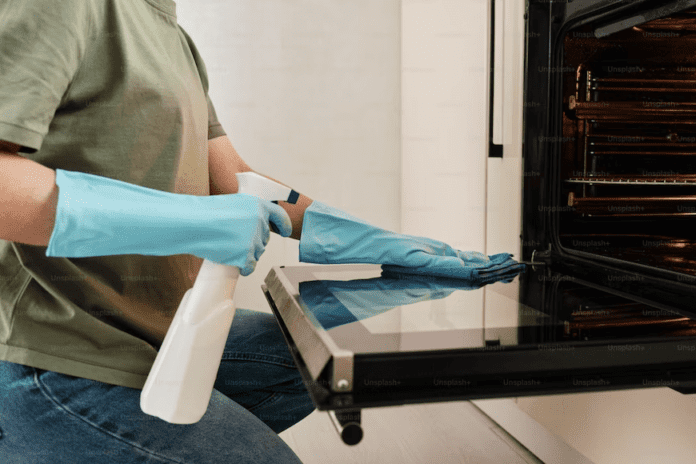1. Washing Machine:
There are many factors besides EPC rating that influence how much a washing machine costs to use, including which cycle you use, the size of the drum, and your energy tariff. But keeping your machine clean is a simple way to ensure costs are kept to a minimum.
Being used so often means washing machines are prone to scum and limescale buildup, which can impact how effective it washes and dries clothes. However a simple remedy of white vinegar and baking soda can go a long way in refreshing both the drum and dispensers.
- Spray white vinegar all around the inside of the drum, making sure to include the rubber door seal too.
- Pour 500ml of white vinegar into the detergent drawer and set to a standard hot wash.
- Add around 60-70grams of baking soda into the drum and run through again.
Cost to clean: £0.88
2. Kettle:
Filling your kettle only with the water you need is one simple way of cutting usage costs, but also making sure it’s free of limescale buildup is essential in order to keep your kettle boiling smoothly. For a homemade remedy, white vinegar works wonders:
- Fill the kettle with a 50:50 mixture of white vinegar and water.
- Boil the kettle and pour contents away afterwards.
- Refill the kettle with only water and boil again, to remove any remaining vinegar.
- This step can be repeated as necessary.
Or for a more intensive clean descaler sachets or tablets are ideal, and there are a multitude of eco-friendly and organic options available. Usually made from 100% citric acid, and with an odourless formula, your kettle will be sparkling like new in only half an hour.
Cost to clean: £0.29
3. Dishwasher:
Cleaning a dishwasher can be a daunting prospect, with the interior walls, filter, drain cover, and shelving racks to contend with. But with the help of just a few household ingredients, you can have it running smoothly and more efficiently again in no time at all.
- Remove the filter from the base of your dishwasher and run it under hot water, using washing up liquid and a sponge or scrubber to remove any grime and buildup.
- Ensure both water spraying attachments are clear of buildup or food waste. If any holes are clogged, a toothpick is ideal to clean them out. Once these attachments have been scrubbed, pop the filter back in.
- A standard clean can be achieved by sprinkling baking soda onto the floor of the dishwasher and set to run on an eco cycle. But if a deeper clean is what you’re after, fill a small bowl with 250ml (1 cup) of white vinegar and place on the top shelf and run through on a hot water cycle without a tablet or detergent.
- Aside from leaving the interior sparkling clean, this deodorises the machine and breaks down any food particles, eliminating unpleasant odours and improving the efficiency of the machine.
- Remember to use a scrubber (or a toothbrush for particularly hard to reach spots) to clean the seal around the door, as it’s a common place for dirt to gather.
Cost to clean: £0.88
4. Microwave:
A weekly clean is recommended to keep a microwave in top working order, allowing energy to be spent on cooking your food, not the built up leftover food as well. Fortunately, harsh chemicals aren’t necessary for the best results, leaving you free to use natural ingredients that you’ll probably already have in your kitchen cabinets:
- Baking soda is ideal for use in home cleaning; as a mild alkali, it’s perfect for easily eliminating grease and grime from appliances.
- In a microwaveable bowl, add two tablespoons of baking soda to 250ml of water, and set on full power for three to five minutes (depending on your machine’s wattage). This method is perfect for breaking down stubborn stains and grease inside, leaving it easier to dislodge with a cloth or scrubbing brush.
- Sprinkling baking soda directly into the base of your microwave after removing the turntable plate, and then wiping around the interior with a damp cloth will remove any remaining dirt. Rinse out the cloth and repeat this step with the turntable elements.
Alternatively, an excellent way to remove grease from your microwave is to cook a lemon. Yes, really.
- Take a microwaveable bowl or jug and fill it to the halfway point, then slice a lemon in two, placing one half into the water and squeezing to release some of the juices (and fresh scent).
- Place in the centre of your microwave and for three to five minutes (again, taking into account your appliance’s wattage) set to run on full power.
- After removing the bowl or jug (whilst wearing gloves, as it will be hot), dip a clean cloth into the water, using it to wipe away any grime which should now come away with ease.”
Cost to clean: £0.89
4. Oven and hob
Cleaning your oven is a dreaded task by many, however spending the time to clean this, and your hob, can be well worth the effort. A deep cleaned oven will reach the correct temperature for cooking much quicker than one covered in food residue and grease. Alongside this, the heat will be distributed more evenly – not only resulting in lower bills – but improving the taste of your food too.
- For a thorough clean make sure to remove the racks and grill plate from your oven first.
- For the interior of your oven, make sure to remove any dirt or crumbs from the bottom with a dustpan and brush
- Mix baking soda and water until you have thick, paste-like consistency. Smear the paste across the metal and glass – but be careful to avoid any heating elements. Leave this for 20 minutes.
- The baking soda is a mile abrasive and an alkaline meaning it should remove grease easily. Simply wipe away after leaving your mixture to work.
- For the racks, a great, easy option is to place your oven racks in the bathtub along with hot water and a few dishwasher tablets. Leave to soak for as long as possible – when removing you should be able to wipe away and grease. Just remember to put down a towel first to avoid damaging your tub.
Cost to clean: £0.59 (£0.80 including x3 dishwasher tablets)
5. Vacuum
While it may seem odd to clean an item designed for cleaning, your vacuum will have much more power if any debris is removed, and it can be surprising how much builds up around the brushes, filter, cylinder and any attachments. Cleaning this away will improve suction power, reducing in less time spent on this chore – and reduced energy usage!
- The first spot to check for any build up is any brushes. If possible remove the brush from any attachments or heads carefully according to your appliance’s instruction manual. Once you have access to the brush, carefully use a pair of scissors to cut through trapped hair and other debris to release it from the brush. Pay close attention to avoid cutting any bristles.
- Remove the cylinder from your vacuum and empty the contents. Once you have done this, use a toothbrush to gently remove excess dirt and dust from the rest of the compartment, taking care to reach spots where any has built up.
- If your appliance allows you to remove the filter and to wash it, remove this and run under cold running water to rinse away any debris. Leave until completely dry before returning to your vacuum. Not only will cleaning this improve suction but it will also help to remove any bacteria and germs.
Cost to clean: £0.00
6. Shower head:
Shower heads can be prone to limescale build up – which not only reduces the power and flow of your water, it also results in you needing to use it for longer – therefore consuming more energy. A simple clean can leave you with a more powerful shower, and a cheaper energy bill.
- A great tool for cleaning your shower head is actually a dental floss pick designed for braces. The tiny wire tool can be great for pushing into the holes of your shower head to release any grime. Gently push the tool into each hole, to get rid of any persistent build up.
- Secondly, fill a zip lock bag with white vinegar, place over your shower head and secure the bag. Leave to soak for 30 minutes to 1 hour then remove and rinse. This should leave you with a glistening shower head, and return its power.
Cost to clean: £1.89
7. Hairdryer
Whether you have a short cut or long locks, many of us use a hairdryer to speed up our routine. However, these can become clogged with dust, hair and other build-up. But removing all this from the back of your dryer and filter can improve its efficiency.
- Most importantly, make sure your appliance is switched off and unplugged.
- Remove the cap from the back and rinse under a tap to remove any dust from here.
- For the filter on the appliance itself, take a vacuum nozzle and gently hold it against to pull any residue away from the filter
Cost to clean: £0.00
Total cost of cleaning items: £3.25
Lastly, it’s worth looking at the EPC UK energy ratings system of any appliance, this is essential when discerning how much money it costs to run. Classified from A to G, with A being the highest, this rating shows at a glance how energy efficient or inefficient an appliance is. The higher the rating, the more money you’ll save in the long term, as those (usually older) appliances with ratings of C or below cost a lot more to run.
*Prices obtained from https://www.tesco.com/groceries, cheapest item selected. Items with multiple uses only counted once. Price given for each appliance is the total cost of products.
Help keep news FREE for our readers
Supporting your local community newspaper/online news outlet is crucial now more than ever. If you believe in independent journalism, then consider making a valuable contribution by making a one-time or monthly donation. We operate in rural areas where providing unbiased news can be challenging. Read More About Supporting The West Wales Chronicle






















